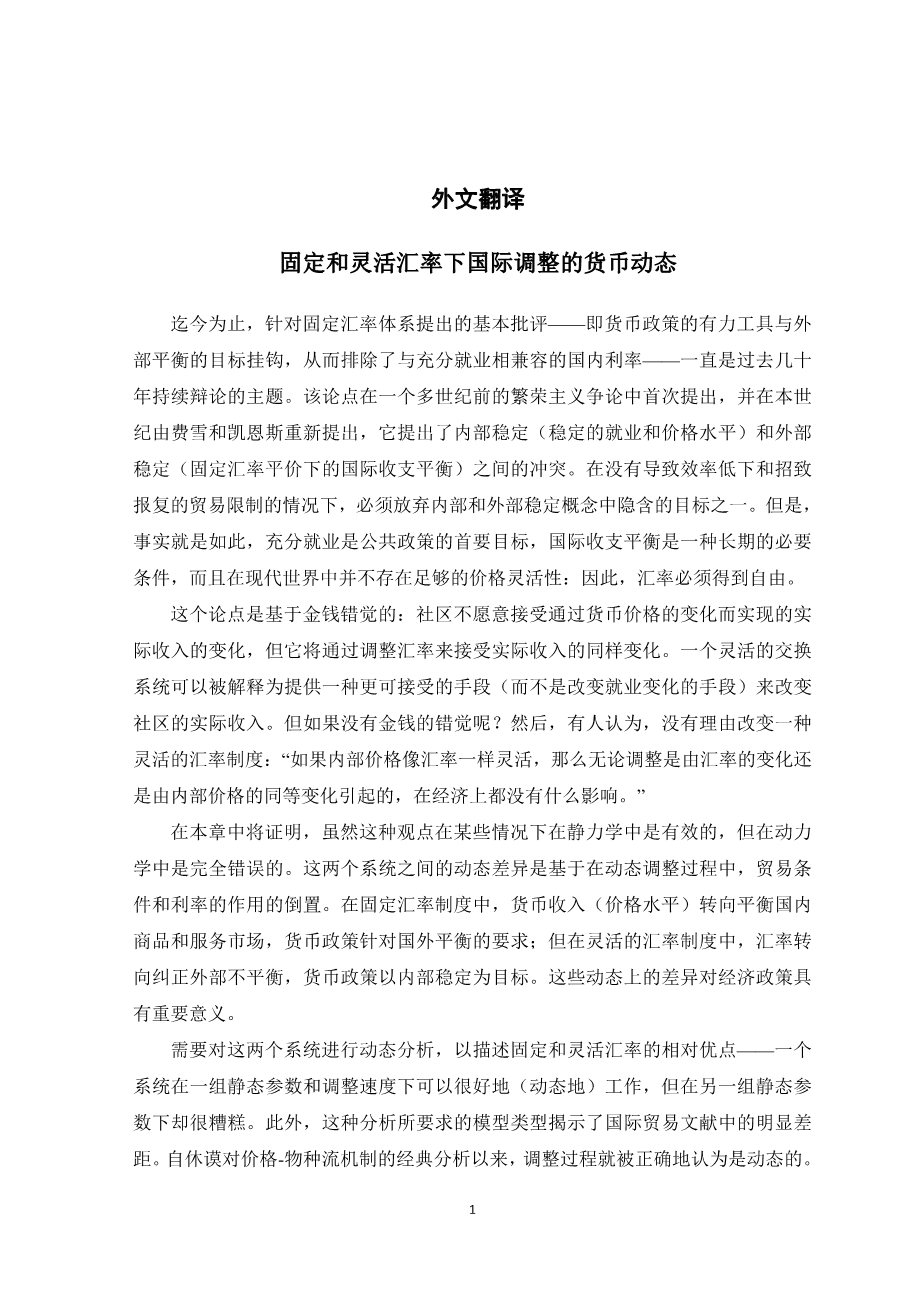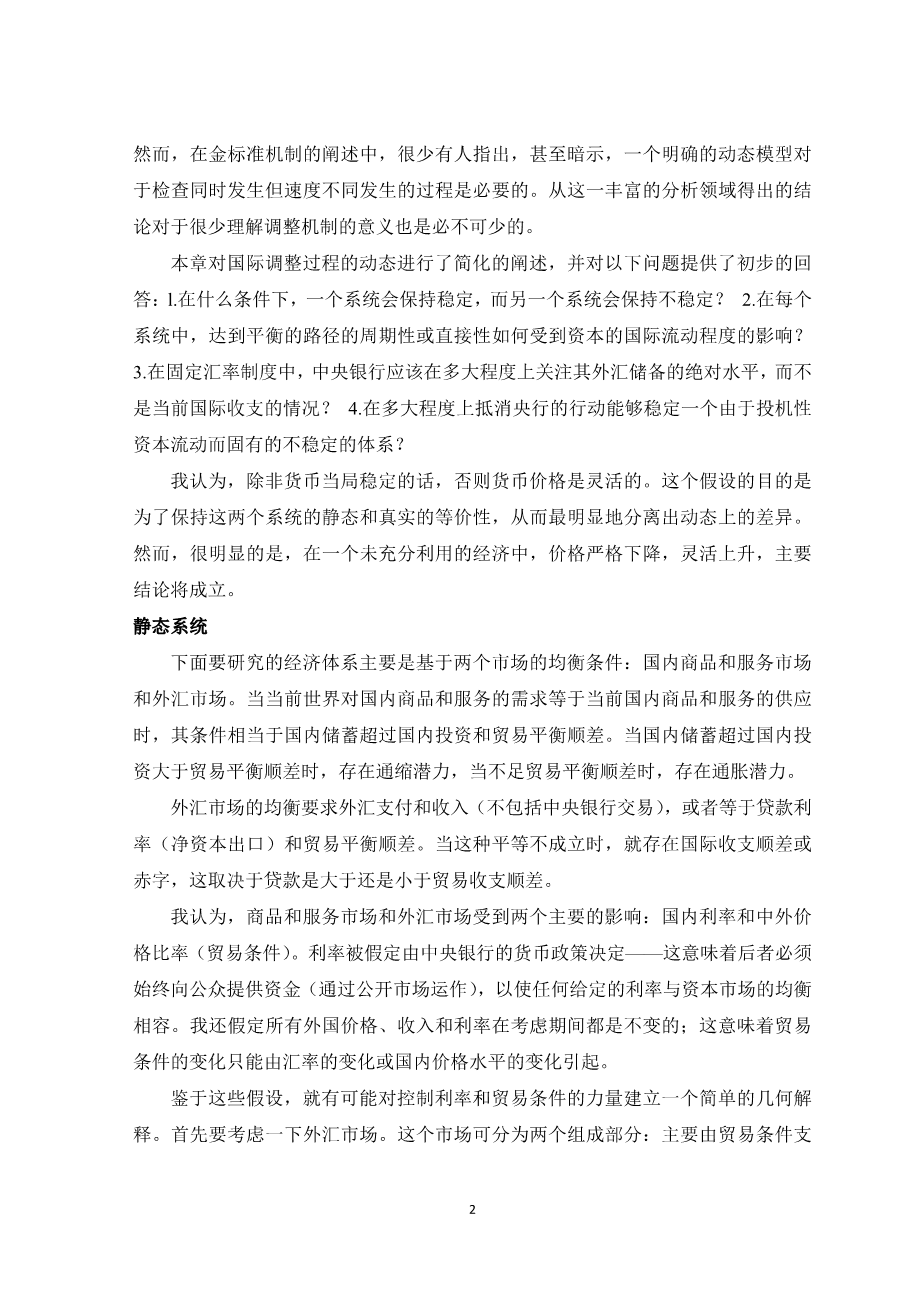The Monetary Dynamics of International Adjustment under Fixed and Flexible Exchange Rates
The basic criticism hitherto advanced against a system of fixed exchange rates -- that the powerful instruments of monetary policy are tied to the goal of external balance thereby ruling out a domestic rate of interest compatible with full employment -- has been the subject of continued debate over past decades. First advanced over a century ago during the bullionist controversy, and revived in this century by Fisher and Keynes, the argument poses the conflict between internal stability (stable employment and price levels) and external stability (balance-of-payments equilibrium at a fixed exchange parity). In the absence of trade restrictions, which cause inefficiency and invite retaliation, one of the targets implicit in the concepts of internal and external stability must be abandoned. But, so the argument runs, full employment is a prime goal of public policy, balance-of-payments equilibrium is a long-run necessity, and sufficient price flexibility does not exist in the modern world: The rate of exchange must therefore be freed.
The argument is based on money illusion: The community is unwilling to accept variations in real income through changes in money prices, but it will accept the same changes in real income through adjustments in the rate of exchange. A flexible exchange system may then be interpreted as a device for providing a more acceptable means (than employment changes) of altering the real income of the community. But what if money illusion is absent? Then, it is argued, there is no reason for changing to a system of flexible exchange rates: ' If internal prices were as flexible as exchange rates, it would make little economic difference whether adjustments were brought about by changes in exchange rates or by equivalent changes in internal prices.'
In this chapter it will be demonstrated that although this view, under certain circumstances, may be valid in statics, it is entirely erroneous in dynamics. The dynamical differences between the two systems are based on an inversion of the roles, in the dynamic adjustment process, of the terms of trade and the rate of interest. In the fixed exchange system money income (the price level) moves to equilibrate the market for domestic goods and services, and monetary policy is directed at the requirements of the foreign balance; but in the flexible exchange system the rate of exchange moves to correct external disequilibrium, and monetary policy aims at the goal of internal stabilization. These dynamical dissimilarities have important implications for economic policy.
A dynamic analysis of the two systems is necessary to provide a description of the relative merits of fixed and flexible exchange rates-one system may work well (dynamically) under one set of static parameters and speeds of adjustment but badly under another. Moreover, the type of model that such an analysis requires reveals a conspicuous gap in the international trade literature. Since the days of Humes classic analysis of the price-specie-flow mechanism, the adjustment process has been rightly recognized as dynamic. Yet it is seldom stated, or even hinted, in expositions of the gold-standard mechanism that an explicit dynamic model is necessary for examining processes that occur simultaneously but at different speeds. The conclusions that follow from this rich field of analysis are essential to even a minimal understanding of the meaning of the adjustment mechanism.
This chapter offers a simplified exposition of the dynamics of the international adjustment process and provides preliminary answers to the following questions: l. Under what conditions will one system be stable while the other system is unstable? 2. How is the cyclicity or directness of the paths to equilibrium, in each system, affected by the extent to which capital is internationally mobile? 3. To what extent should the central bank be concerned, in the fixed exchange system, about the absolute level of its reserves, as opposed to the situation in the current balance of payments? 4. To what extent can offsetting central bank action stabilize a system that is inherently unstable because of speculative capital movements?
I assume throughout that money prices are flexible unless stabilized by the monetary authorities. The purpose of this assumption is to maintain the static and real equivalence of the two systems and thereby isolate most clearly the dynamical dissimilarities. It will nevertheless become clear that the main conclusions would hold in an underemployed economy in which prices were rigid downward and flexible upward.
The Static System
The economic system to be investigated below is dominated by the conditions of equilibrium in two markets: the market for domestic goods and services, and the market for foreign exchange. Equilibrium in the goods-and-services market is assumed to prevail when the current world demand for domestic goods and services is equal to the current supply of domestic goods and services, a condition which is equivalent to the equality of the excess of domestic saving over domestic investment and the trade balance surplus. When the excess of domestic saving over domestic investment is greater than the trade balance surplus there is deflationary potential, and when it falls short of the trade balance surplus there is inflationary potential.
Equilibrium in the foreign exchange market requires equality of foreign exchange payments and receipts (excluding central bank transactions) or, equivalently, equality of the rate of lending (net capital exports) and the trade balance surplus. When this equality does not hold, there is a balance-of-payments surplus or deficit, depending on whether lending is greater or less than the trade balance surplus.
I
剩余内容已隐藏,支付完成后下载完整资料


英语译文共 12 页,剩余内容已隐藏,支付完成后下载完整资料
资料编号:[588038],资料为PDF文档或Word文档,PDF文档可免费转换为Word


